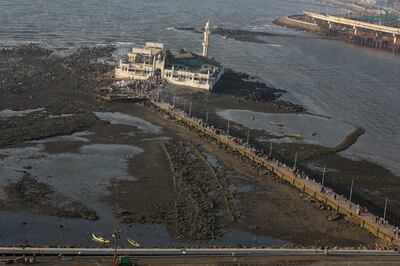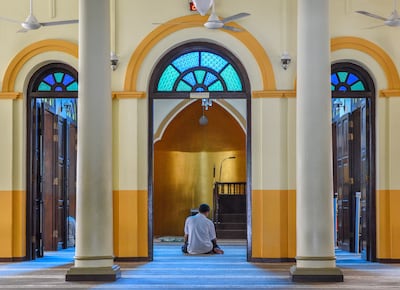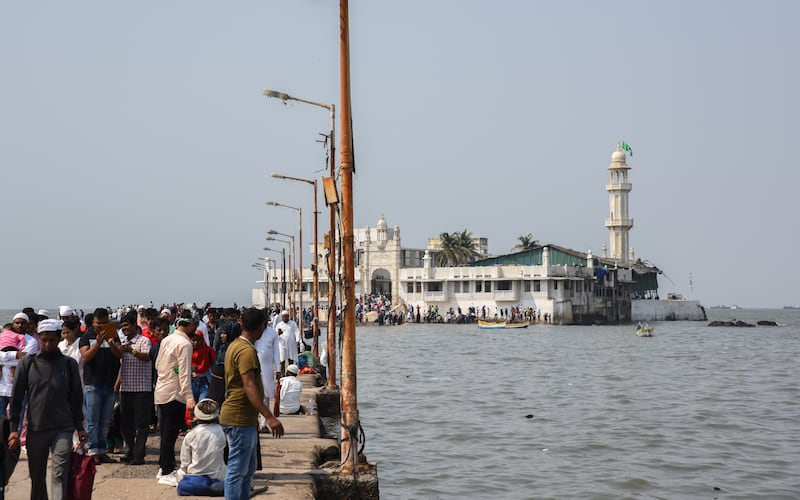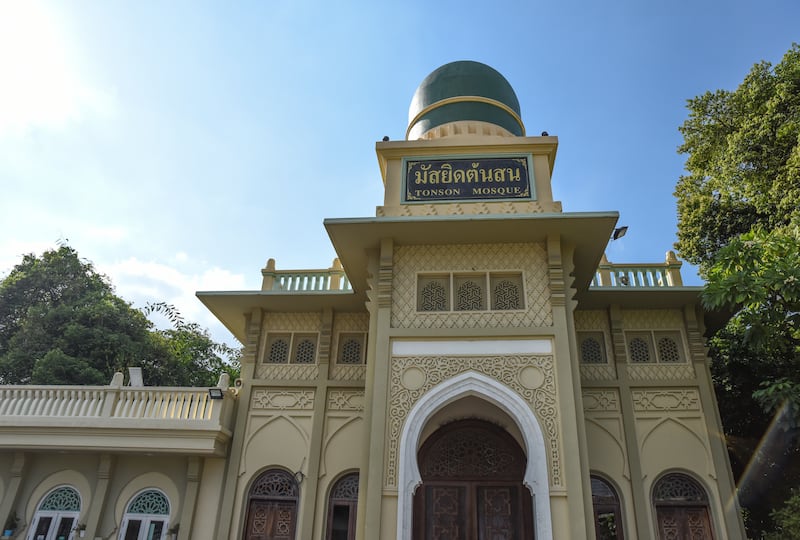Islamic masterpieces decorate lands around the world, with many glorious mosques built outside the Middle East and North Africa.
From Singapore to Scotland, Bali to Bulgaria, tourists can visit mosques that are dazzling in design and rich in history. And while not all of them are open to non-Muslim visitors, they can all be admired from the outside. Here are 10 fascinating Islamic houses of worship in non-Muslim-majority countries worth seeking out.
Haji Ali Dargah – Mumbai, India

Just reaching Mumbai’s most famous mosque is, in itself, a memorable experience. This Indo-Islamic-designed structure sits in the middle of Haji Ali Bay, and is only accessible when the tide is relatively low, meaning worshippers and tourists can cross its 200m-long footbridge. Haji Ali Dargah is conveniently located within 1km of three other terrific tourist attractions – the National Museum of Indian Cinema, Nehru Planetarium, and the unique Dhobi Ghat, reputedly the world’s largest open-air laundry system.
Edinburgh Central Mosque – Scotland

Edinburgh has one of Europe’s finest Old Towns, a sloping, cobblestone area lined by sublime heritage buildings such as St Giles Cathedral and the National Museum of Scotland, commanded over by Edinburgh Castle. Comparatively youthful, but similarly beautiful, is this neighbourhood’s Edinburgh Central Mosque. Facing the leafy University of Edinburgh, this large house of worship was built in 1998 and is embellished by a minaret and towering arched entrances.
Grand Mosque of Paris – France

One of Paris’s most picturesque buildings is not a cathedral or palace but a North-African-inspired mosque. France has Europe’s largest Muslim population, most of whom have their roots in Morocco, Tunisia or Algeria. This influence is evident in the century-old Grand Mosque of Paris’s lattice work, Moroccan zellige tile mosaics and square-shaped minaret. Tourists will also appreciate its cafe, shady gardens and location adjacent to the Jardin des Plantes botanical garden and National Museum of Natural History.
Nurul Huda Gelgel Mosque – Bali, Indonesia

Bali’s enduring tourist appeal derives from its endless beaches, bargain resorts, jungle interior and literally thousands of Hindu temples, such as the eerily fascinating Goa Lawah bat temple. A short distance west of this site is the oldest mosque on what is the only Hindu-majority island in this vast Muslim nation. Nurul Huda Gelgel sits in the peaceful, historic village of Gelgel in Bali’s south-east. Built more than 400 years ago, it is adorned by a gilded minaret, sublime pointed arches and Islamic calligraphy.
Sultan Salahuddin Abdul Aziz Mosque – Selangor, Malaysia

Malaysia’s largest mosque is a hidden treasure.
Not just colossal but also spectacular in design, Sultan Salahuddin Abdul Aziz Mosque is located just far enough from Kuala Lumpur that it escapes the attention of most of the millions of tourists to that city each year.
It is also called the blue mosque, due to the colour of its massive dome and the accents on its quartet of 142m-tall minarets. The complex is located in Shah Alam city, which also has the Sultan Alam Shah Museum, Imperial tombs and serene National Botanic Gardens.
Banya Bashi Mosque – Sofia, Bulgaria

Ottoman influence is etched across Sofia, the capital of Bulgaria, which was under the umbrella of that giant Islamic empire for five centuries. Tourists wandering its downtown, home to key attractions such as Sofia Central Market and the Cathedral of Saint Nedelya, will spot the generous dome and slender minaret that top the city’s oldest mosque. Built 500 years ago, Banya Bashi Mosque is even more glorious inside. Visitors are particularly beguiled by its ceiling, cloaked in densely layered floral designs.
Al-Abrar Mosque – Singapore

Renowned for its lively markets and bargain hawker food centres, Chinatown also has one of Singapore’s most significant mosques. In a city-state that’s become defined by brash modernity, Al-Abrar is a throwback. Almost 200 years old, it is a petite, simple structure in various shades of cream. Its only real design flourish is stained glass windows that fill it with polychromatic light. Few buildings in Singapore are older than this mosque, which was established by Muslim settlers from India.
Adelaide Mosque – Australia

Concealed by the giant shadows of Sydney and Melbourne, Adelaide receives scant attention from tourists. Yet it’s neat city centre is lined with museums, dotted by parks and full of historic sites, including the oldest mosque in the country. Near the stunning Leale Gardens are the shimmering white minarets of Adelaide Mosque. It was constructed in 1888 by a community of Afghan and Indian cameleers – men who carted goods across Australia on the backs of camels. It remains the hub of Adelaide’s Muslim community.
Ton Son Mosque – Bangkok, Thailand

Ton Son Mosque is just a 500m walk from one of Thailand’s most visited attractions, the mosaic-laden Wat Arun, also known as the Temple of Dawn. Yet few tourists divert here, into Bangkok Yai, the Thai capital’s oldest Muslim area. Since the 1680s, this community has been centred on Ton Son, which is surrounded by trees, adorned by Arabesque patterns and topped by a large green dome.
Al-Serkal Mosque – Phnom Penh, Cambodia

Considering Phnom Penh’s relatively small Muslim population, its Al-Serkal Mosque is surprisingly large. The skyscraping minarets and grand domes of this 2014-built mosque – funded by the UAE – are just a few minutes walk from tourist landmarks like the hilltop Wat Phoun temple, historic Raffles Hotel and teeming Central Market.















